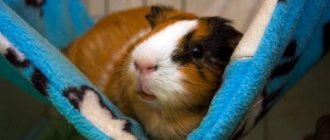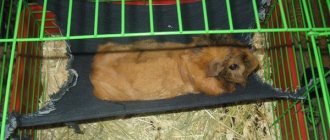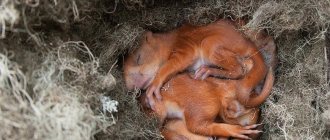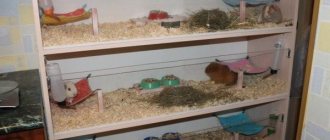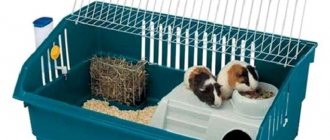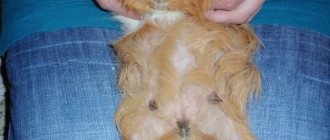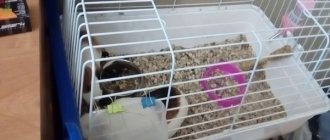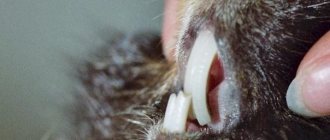Guinea pigs are pets, but they cannot stay indoors all the time. Some people prefer to walk them on a leash, but it is more convenient for both the owner and the pet to use an enclosure.
We will learn how to build a spacious pen for guinea pigs with your own hands: what standards to follow and how to equip the room.
What should a home be like for a guinea pig?
When choosing a home for a pet, pay attention to several factors.
Firstly, the house must be spacious. The pig must fit there freely. The opening for entry and exit must allow the animal to pass through, eliminating the possibility of getting stuck.
Secondly, the use of toxic materials, paint or varnish is unacceptable. A rodent can taste its home and become poisoned.
Thirdly, protruding screws or nails are not allowed in the design of personal housing. It is also recommended to check for cracks. There should be no holes in the house in which the pet’s paw could get stuck. It is not recommended to choose products with sharp parts, such as pointed turrets. They can injure the pig.
Fourthly, the air in the home should be well ventilated. To do this, several holes are made in the house. An animal can use them to enter and exit its home, or as windows.
Making a cardboard house
To make a structure from sheets of thick cardboard, you will first need to make drawings. The steps are similar to the process of making a house from wooden plywood. But in the case of cardboard, you will need a safe, non-toxic glue instead of nails. The advantage of cardboard is the ability to make carved decorations without much effort. A house decorated with beams and carved elements looks more attractive
It is important to remember that the glue must be allowed to dry completely before using the finished product for its intended purpose.
Corrugated cardboard can be used as a material.
Toys from improvised means
Inventing and making toys for small rodents at home is not only useful, but also exciting. In addition, making accessories yourself significantly saves the family budget.
Most often guinea pigs are offered:
- improvised grinding stones that are hung just above the floor of the cage - the animals first play with them, and then happily gnaw on them and grind down their incisors;
- old wooden cubes;
- soft toys - as a rule, rodents first sniff them, then take them to their house; a disheveled toy must be promptly replaced with a new one;
- Tennis or ping-pong balls are one of the most favorite toys of guinea pigs - they push the balls with their paws, head, and roll them around the cage;
- tubes from large paper napkins;
- wire (or twine) with treats strung on it.
Communication with other guinea pigs
Animal care experience shows that two female guinea pigs can easily get along together at any age. It also turns out that a male and a female have a good family, but then you need to be prepared for constant replenishment of the family. One male and several females live together.
Two males sometimes get along only if there is no female nearby. It is possible that they will suddenly want to fight, even if they have spent a lot of time together before, so it is better not to keep two boys together. These contractions can be very brutal. But these animals never fight over food.
After acquiring a second guinea pig, you should not immediately place it with your pet; it should live separately for at least a week. This is to make sure that the new pet does not suffer from any diseases. After the end of the week-long quarantine, you can bring them together.
Photo: Depositphotos
Before meeting, you need to thoroughly clean the walking area so that there are no foreign odors there. Food needs to be scattered throughout the cage to avoid conflicts over food. After the pets have been united, it is advisable to look after them all day.
Guinea pigs will sniff each other and squeak. By low whistling, animals communicate a threat or it is a sign of normal courtship. They may also grumble and chatter their teeth. The last gesture, combined with raising its paws and body, means that the animal tells the enemy that it is ready to start fighting for primacy.
Guinea pigs may begin to walk around another animal in circles and jump on each other. Usually, pouncing is an expression of sexual behavior, but sometimes, if the animals are same-sex, it means that one of the guinea pigs wants to show dominance to the other. Females who are harassed by a male may retaliate by releasing a stream of urine at him.
All of the above is normal and should not be alarming. Usually after a few days the animals calm down. But if it comes to a serious fight, the guinea pigs need to be separated with a net and after a while try to bring them together again. Sometimes all attempts to reconcile animals are pointless. Then you need to think about another partner.
Photo: Depositphotos
Minimum requirements for size and arrangement
At the initial stage of building a cage, you should take into account the optimal dimensions of the home. Generally accepted standards are:
- One rodent occupies 70*100 cm.
- Two individuals - 70*140 cm.
- For three animals - 70*170 cm.
- Four pets - 70*210 cm.
Before you start constructing a cage, you must take into account the following conditions:
- Selecting a location for the cage. The room in which the pet will be kept must be dry, clean, and equipped with ventilation. For contact with an animal, it is better to choose a room in which all family members gather for long-term communication. A rodent will adapt faster if it hears human speech.
- The cage must be installed on a stable plane; tilting and shaky surfaces are not allowed.
- The height of the finished product should not be less than 35-40 cm. If the animal is large and, standing on its hind legs, reaches the upper border of the wall, then the height should be increased.
- If there are other pets in the house, it is recommended to install a ceiling. It will be able to protect the animal from aggressive animals or objects falling from above.
- For elderly guinea pigs, it is not advisable to make a cage with many levels.
- Walls and floors should be well illuminated with natural light, away from heating devices and no closer than 50 cm from the external walls of the building.
Step by step construction
When the diagram is ready and all materials and tools have been collected, you can begin construction.
Important! If the space allows, the size of the home can be increased. This will give the animals more freedom.
Making the base
The shape and parameters of the lower part are dictated only by possibilities and imagination. The shape of the bottom is applied to the cardboard and a distance of 15 cm is measured on each side and lines are drawn (red for cutting only the top layer, black for cutting through). These will be the sides of the structure.
The upper level is cut along the marked lines. The protruding ends of the sides are secured with adhesive tape. The result is a rectangular base with 15 cm sides.
Wall assembly
The walls are assembled from metal gratings, cut into panels of the required size, 30 cm in length and 30 cm in height. If a multi-level enclosure is planned, the height should be greater. The edges are processed and folded so that the rodent does not get hurt.
Important! The walls should not be tied too tightly - it may be difficult to connect the lattice on the opposite side of the cage.
In the end, all that remains is to connect the lattice walls to each other according to the shape of the base. The edges of the walls are secured with cable ties. The sides are tied not only at the top and bottom at right angles, but also in the center. It is better to assemble each wall separately so that you can adjust it to size later.
Connecting the box with the bars
The lattice walls are secured to the bottom with cable ties. Since the body will be built inside the base, it must fit exactly in size.
What does this little animal need?
First of all, of course, a spacious cage, made of metal rods with a high plastic tray, which can be easily removed if necessary. It is better to buy a large cage in advance with the expectation that the animal will grow up. Pigs are active, they need to run, otherwise their legs will be weak, and the animal will begin to suffer from obesity from the fact that all the time it just lies in the cage and eats its food. From time to time, it is advisable to let them run around the room (it is better to limit it to one room), and then the animal itself will not move further than it until it has explored everything, and this can take more than one week.
In addition to the cage, you need a feeder for hay and fresh grass (it is usually attached to the wall of the cage), a cup for grain feed (preferably a heavy ceramic one so that the pig cannot accidentally knock it over) and a nipple drinker. And don’t forget to buy filler for the cage; it’s best to buy regular sawdust, not granular ones, since pigs love to bury their heads in sawdust. You can also buy a mineral salt stone, on which the pig can grind its teeth; it is better to choose a round stone with a hole in the middle; it can be hung in the cage.
You also need a piece of tree bark or driftwood on which your pet can grind its claws, or you can buy special scissors at a pet store and trim your pet’s nails yourself, but I’ll warn you right away: this is not an easy task.
You can purchase a special wooden house in which the pig will sleep or can hide in case of danger.
Why do rats use shelter?
Tame domestic rats may use the cage house quite rarely, but this does not mean that they do not need it. All pets need shelter at certain times.
Stress
Even very tame rats are frightened by unfamiliar people, changes in their usual routine, and loud noises. Without a place to hide, your pet will develop stress, which can lead to aggression.
Bad mood, malaise
If an animal feels unwell, it feels an instinctive need to hide, to make sure that it is reliably protected.
How to set up a cage for a guinea pig?
It is not enough to make a cage, you need to equip it, creating comfortable conditions for existence for the animal. Here's what a pet might need in a pen:
- Bed
. Many people are interested in whether a guinea pig needs a house in a cage. Experts say it is needed. Here the animal can take a break from human attention. It can be made from the same plywood or sewn into a soft sleeping bag. - Drinker and feeder
. There is no need to explain why these elements are in the cage. - Hay tray
. Guinea pigs are constantly chewing on something, and they especially love fresh grass. It is better to design a special compartment for them so that the hay does not lie all over the cage. - Ladder
. It is necessary if the cage has several floors. - Toys
. Pigs especially love products like a hole or a labyrinth. You can use for this purpose a piece of ordinary plastic pipe with a diameter corresponding to the size of the animal. - Hanging accessories
- hammocks and metal balls filled with hay or vegetables and fruits.
https://youtube.com/watch?v=NV-VbfnTiV4%250D
Guinea pig bedding in a cage
Animals need a warm and comfortable covering. There are several options for checkered bedding that are especially popular:
- Rug for a guinea pig in a cage, made of polyvinyl chloride (PVC)
. Such products are sold in large rolls, which makes it easier to manufacture the desired bedding. It is easy to care for such a rug, because you just need to shake it out, wipe it with a wet cloth and you can put it back in place. It is recommended to machine wash it once a week. - Fleece liner
. This fabric is well known to parents of small children. It is soft, warm and pleasant to the body. Fleece is waterproof, and sawdust and small debris can easily get stuck in this fabric. However, if you take care of the litter and wash it often, it looks aesthetically pleasing. - Bedding made from disposable diapers
. These are sold at pharmacies or pet stores and can be used as a rug. The only condition is that they need to be changed in a timely manner.
Guinea pig cage litter
Rodent owners use a variety of fillers:
- Sawdust
. This is a lightweight, soft and environmentally friendly material that is chosen by many. This filler should not contain too rough or sharp wood chips. - Wood pellets
. Arranging a cage for a guinea pig can be done using this filler. It absorbs moisture and odors well and emits a pleasant pine aroma. It can be covered with a PVC mat and thereby obtain a thick and warm bedding. - Plain paper or newspaper
. Cheap option that requires frequent replacement. - Corn granules
. They are harmless to guinea pigs, do not cause allergic reactions and smell good, but animals can eat them, so this type of litter also needs to be covered with a rug. - Wood shavings
. It must be well dried and free of resin, otherwise the animal may be poisoned by toxins, especially if a closed guinea pig cage is used.
Guinea pig toys in a cage
There are also a lot of options here, because there are so many breeders, so many ideas.
Those interested in how to equip a cage for a guinea pig and what to offer for leisure activities should pay attention to:
- Paper bags
. Pigs happily climb inside, chew on the walls and play with these objects. - Cardboard roll from toilet paper or towels
. Depending on their size, pets can climb inside and hide there, playing with each other. - Bricks and stones
. Necessary for sharpening claws and teeth. - Old socks stuffed with straws
. Pigs can use them as a pillow. - A towel fixed on the bars
. This improvised hammock will be loved by many pets.
Cell parameters
We will talk about the minimum size of a pet house. There are no maximum size restrictions, especially if you have multiple animals. The larger the guinea pig cage, the more comfortable your pets will live.
With a width of 60 cm, the length of the structure should be 100 cm. If two animals live in a cage, then its length should be 20 cm longer. When keeping three animals, you need a cage whose length is 150 cm. But if we are talking about 4 or more animals, then experts do not recommend keeping them in cages. In this case, you need to equip a spacious enclosure.
Article on the topic: Carrying for a guinea pig and rules for transporting a pet in transport
All walls of the guinea pig cage must be made of metal mesh. If you use fiberboard or other solid material, there will be insufficient light and poor ventilation in the cage, which will lead to health problems. The minimum distance between the rods should be 15 mm, and the maximum - 25 mm. In houses for small piglets, the distance between the rods should not exceed 10 mm. If you decide to paint the rods, then pay special attention to the choice of paint. Guinea pigs have a habit of gnawing all objects, including elements of their own home. Therefore, you need to use paint that, if ingested by your pet, will not harm your pet’s health. It is best to leave the rods unpainted.
Note that even such popular models of guinea pig houses as ferplast cavie 80 or ferplast arena 80 are small in size and do not quite comply with the standards described above. And their price, at the same time, is quite high.
In the room where the guinea pig cage is located, the air temperature should be 22 degrees and the air humidity should be 50%. A slight deviation of these indicators in both directions is allowed.
What types of enclosures are there?
Enclosures can have different “interiors”. You can make some kind of tunnels and pipes so that the animal can run and hide through them. This is often made from cork oak. Guinea pigs enjoy a variety of bridges. They can be made from bark. Ceramic toys and wicker baskets can be placed in the pen.
It is better to place an absorbent diaper on the floor in the enclosure. Old linoleum will do. You can throw on pieces of an old natural rug. Don’t forget to sanitize all this in a timely manner.
You can organize a walk for your guinea pig using a fence purchased from a pet store.
Necessary materials
- Multilayer and dense corrugated cardboard, Metal mesh or grid with a mesh no larger than three centimeters, Ordinary plastic cable ties, Knife, Scotch tape, Large and small scissors, Pencils or markers for marking, Ruler.
It is best to use cardboard from large household appliances. It's more durable.
To ensure that the cardboard does not allow moisture to pass through, it must be glued on the inside with tape in two or three layers. Some people prefer to cover the inside with acrylic or even fiberglass. Cardboard is an ideal material - it is light, easy to work with, odorless and harmless, and also easy to find. You should be careful when choosing a metal mesh. The recommended mesh is three centimeters, but if you are keeping a family of pigs and planning to produce offspring, you must choose a mesh with a mesh no larger than a centimeter. Otherwise, the kids will crawl all over the apartment.
How to arrange it?
Objects inside the home should be well attached to the walls or located on the floor. Inside the cage it is necessary to place a drinking bowl, a feeder, a tray for hay, toys, and wooden sticks. It is also necessary to provide the animal with a place of privacy.
With the help of a drinking bowl, the individual will not splash water onto the litter and will not be able to wet itself. The volume of the drinking bowl may depend on the number of pets inside the cage. If there are a lot of animals, then you can use several small drinking bowls.
There must also be a food area inside the individual’s home. It is necessary to purchase several feeders to sprinkle different types of feed. Green, juicy and tough food should be placed in different feeders.
A rodent that lives at home needs conditions similar to natural ones. The pet needs rough materials so that it can grind down its teeth. You need to put twigs inside the cage, but you shouldn’t put coniferous branches. Branches that have large bones inside the fruits must be dried in advance. You can also put a mineral stone inside the cage.
You can place hanging accessories as they will not cause injury to your pet if they are installed and secured correctly. For example, it is worth taking a closer look at hammocks on which sea pets can relax.
The animal is shy and modest. Next to caring people, the individual will become more sociable and bolder. But your pet still needs an area so that he can have some privacy. Inside the cage you should arrange a secluded corner, for example, a house.
If there are many rodents inside the cage, they will fight for it. Instead of a simple house, you need to put up a canopy or fence the entire cage with good material. Another option is to use a pipe made from compressed hay.
If a guinea pig is constantly hiding inside the house, then it will be impossible to tame it, since inside it the animal may feel isolated and cannot see people. In order for the pet to get used to the person, the house needs to be temporarily replaced with a handful of hay.
You should buy toys for the animal so that your guinea pig can have some fun. With the help of toys, your pet will be able to quickly explore the entire territory of the cage. In order for the animal to move more, you need to constantly change toys.
If you put a ball of hay in a cage, many rodents will be able to pull the straws out of it. But this design will not be convenient for eating. You can put both a special tray and a ball.
These pets feel comfortable in an area that looks like a hole. For this reason, it is necessary to purchase toys that are shaped like a pipe. If several animals live inside the cage, then you need to purchase several pipes. Pipes can serve as a shelter if pets conflict with each other. Also, pipes and labyrinths can make your pet’s life more interesting.
The animal can become interested in various labyrinths for a long time. The main thing is that the rodent is active, as this has a good effect on the pet’s health - it will not become obese.
To learn how to make a cage with your own hands, see below.
The purpose of the house and the rules for its installation
It is important to understand that the house is not a decorative item or decoration for the cage. It performs a practical function and is a kind of shelter for a rodent. In the house he can retire, hide, calmly enjoy his favorite delicacy, and have a comfortable rest.
A prerequisite is the purchase of this accessory if you plan to breed chinchillas. The female needs a secluded place where no one can see the babies and interfere with caring for them.
These animals prefer to sleep during the daytime. In order to create good conditions for relaxation, the house should be placed in a corner with the least intense lighting, where twilight remains during the day.
The best option is to install the accessory on the floor of the cage. If you purchase a suspended structure or plan to place your home on a shelf, then it is important to ensure high-quality fixation. This will prevent the risk of falling and injury.
Pros of a cage made by yourself
A do-it-yourself guinea pig cage, made of thick cardboard and mesh, has many advantages over its store-bought counterpart. This is not only a significant saving of money. This is an opportunity to make a really large cage for a whole family of guinea pigs with several levels, shelters and ladders. A homemade cage can have a different shape and design and fit harmoniously into the interior of an apartment or even a balcony if it is insulated. A bedding made of soft and durable fleece will bring big savings. You don’t need to change it every time—just clean it of debris, rinse it under water if necessary, and put it back. A homemade cage will allow you to add new levels or houses or change the design after some time. You can create a cage in the shape of the letter L, multi-story, vertical - everything is limited only by the imagination of the breeder. From leftover building materials you can make a house for a guinea pig, a nursery for fresh grass or hay, a ladder or a labyrinth. The mesh makes a wonderful and comfortable crib.
Self-made cages are more durable and easier to use, and the animals feel free and happy in them.
You can find different versions of drawings - from the simplest to the most complex, and production will not take much time.
Recommendations
The description of the construction process does not contain recommendations regarding covering the structure. This is due to the fact that the animal is not able to jump high. Therefore, the roof, which is installed in houses for birds solely to prevent them from flying away, is not needed in buildings for guinea pigs.
Another important point concerns such an element of a pet house as a false bottom. Its presence greatly simplifies caring for your pet. It is made from a mesh, which is installed 5-7 cm above the main bottom. The space between the bottom and the false bottom is filled with filler. Accordingly, with this arrangement of a house for a guinea pig, it will not move through its own waste and filler. But the presence of a false bottom significantly increases the risk of injury to the structure. Even if you manage to avoid problems such as dislocations and fractures, your pet will certainly begin to form corns. Alternatively, you can place a PVC mat on top of the false bottom. But feces will not pass through it. Accordingly, this solution will not simplify cleaning.
Article on the topic: Choosing a cage for guinea pigs: the correct sizes, materials of manufacture and a review of popular brands
How to choose and where to place?
Before getting a guinea pig, you first need to purchase a cage to house it. Since there is a chic assortment of pet houses on the market, it will be difficult to make the right choice in favor of one model or another.
When purchasing cells, experts recommend paying attention to the following parameters:
- Design size. Guinea pigs need horizontal space and there should be plenty of it. The larger the area of the house, the more freely the animal will be able to move. In cramped cages, the rodent will begin to feel sad and sick. Since on average it is necessary to allocate at least 70 cm2 per pig, the best option would be to purchase a cage measuring 75x90 cm. For two individuals, therefore, a larger structure will be required.
- Free access to cleaning and ventilation. Since the furry house should be cleaned and washed regularly, its design should have removable elements.
- Quality. All locks, doors and bars must be secure. Metal cages are a good choice for keeping guinea pigs; they are the most durable. A combined structure made of plastic and metal rods is also suitable for comfortable housing.
- Form. Rectangular designs are best suited for pigs; it is not recommended to buy multi-level and tall models.
- Ability to fold and disassemble. Prefabricated models are universal because they are easy to store and transport.
- Distance between rods. They should be at such a distance from each other that the animal cannot stick its head through. The ideal option is 2.54x10.2 cm.
- Compliance with the design of the room. Today, manufacturers produce various cell models that differ in color and decor.
After the rodent cage has been purchased, the only question left is its arrangement and selection of a place for installation. It is worth immediately noting that the position of the cell is of great importance. For example, it is not recommended to place the house in or near the kitchen. This is due to hygiene standards
Therefore, in order to correctly locate the rodent’s habitat, it is important to take into account several factors.
- Microclimate of the room. Air temperature and humidity should always remain constant. The animal feels comfortable in a temperature range from 18 to +22 degrees, while the optimal humidity level is considered to be at least 40%. Since in winter there is often a temperature difference in the rooms, the cage cannot be placed on the floor; a bedside table or table is suitable for it. It is also not recommended to place houses with guinea pigs near doors and windows, since drafts are possible.
- Activity. This type of animal loves to be constantly close to people and requires special attention and care from its owners. Therefore, in order not to leave your pet alone, you can place it in the living room. But in this case, you will have to provide in advance the presence of a shelter in the cage where the rodent can hide when it gets tired.
- Noise. Guinea pigs have acute hearing, so their houses should not be placed near sources of loud sounds (TV, stereo system).
- Protecting your pet from other animals and children. It is advisable to place the cage in such a way that you can watch the kids play with the pet. If there are cats and dogs in the house, it is best to place the houses on a hill.
Some guinea pig owners arrange housing for their pets not in the house, but outside, under a special canopy. Such structures must be protected from the penetration of predators and bad weather. If the rodent lives in an apartment, then in the summer it is recommended to take it with you to the dacha. Fresh air and an assortment of green complementary foods will bring your fluffy a lot of pleasure and joy. In this case, the cage should be placed in a place where there is no extreme heat, dampness, cold, and there is protection from direct rays of the sun and rain.
There are also certain restrictions on the placement of cells, so they cannot be kept in the following places.
- On the windowsill on the sunny side and under the glass roof in the greenhouse. It will be very hot for the animals there.
- In the garage. Exhaust gases constantly accumulate in this room, which are poisonous and dangerous not only to the health of the animal, but also to humans.
- In unheated rooms. This type of pet should not be overheated or overcooled. It is also not allowed to warm the room where the pig is located with kerosene gas or a kerosene lamp. These heat sources emit many harmful gases.
How to make a cage for a guinea pig with your own hands, in detail
What are the benefits of handmade houses:
- You choose the material yourself.
- By making the design yourself, you will save your family budget.
- If the pet is no longer alone, there is the possibility of increasing and completing the home.
- You choose the interior and contents of the house yourself.
- This is a creative and entertaining process that even children can get involved in.
Design parameters:
- One animal, required space 70*100 cm.
- Two, the required space is 70*140 cm.
- Two - three, required space 70*170 cm.
- More than three, they need an area of 70*210 cm.
Things to consider when designing a cage:
- The cage requires a flat surface.
- The height of the cage should be at least 40-50 cm. The pigs rise on their hind legs, the side walls should be higher than the animal at full height.
- If there are other animals in the house besides the pig, the structure must have a top.
Precautions when constructing the cage:
- It is not recommended to use plastic as a pallet. Better plywood.
- Use a mesh with a square diameter no larger than 2.4 mm. Take care of your pet's safety.
- The joints should not have any gaps.
- If the structure has ascents or descents, they must be secured with side fastenings.
Step by step assembly:
The design is very simple and low cost. Making the base of the structure. Environmentally friendly material – corrugated cardboard. You can purchase whole sheets, or you can use part of the box. This material is convenient to use and can be easily replaced later.
On a sheet of cardboard we draw a diagram of the future base. The height of the sides of the base is no less than 20 cm. We make side cuts according to the base pattern, bend the sides, and fix all the folds with tape. The box will be in the shape of a rectangle. We glue the surface of the cardboard with tape, the bottom should be waterproof.
The next step is to form the side walls. To do this, we use a grid with a square division of at least 25 x 25 mm; for children it is better to use a square diameter of 10 x 10 mm. The mesh can be purchased at any hardware store. Ready-made metal plates and rolled mesh are also suitable for this. We fasten the plates with ties. The mesh should be pre-cut to size, the sections should be cleaned, there should be no sharp areas, and connected in the same way as the plates.
Let's start connecting all parts of the structure. We make holes in the cardboard to connect to the mesh. We assemble using zip ties. Don’t forget about the lid, it’s more convenient to make it in two parts and takes up less space when opening. It can be removable, you can attach one side to the structure.
The structure is ready. Let's move on to filling, because it determines how quickly the pet will get used to the new environment.
Comfortable home:
- Install at least two feeders. If there are a lot of animals, there should also be several feeders. Otherwise, someone will remain disadvantaged and hungry.
- It is better to make drinking bowls yourself, since purchased ones are expensive and may not be understandable to animals.
- Set up an overnight stay. This is an individual place, everyone should have their own.
- Don't forget about ups and downs and toys.
Manufacturing procedure
To prepare for work, a diagram is made taking into account all specific dimensions. You can take any drawing of a rack or shelf as a sample. Substitute your dimensions, making sure to check whether the rack will fit in the space allocated for it.
Rack drawing
Don't make the shelves too deep, as this will make cleaning difficult. The distance between floors should be sufficient so that the pigs can stand on their hind legs if necessary. Once the drawing is ready, start manufacturing:
The finished diagram is transferred to the material using a marker with a ruler. To cut parts from wood, use a jigsaw or hacksaw. If necessary, a frame is assembled from wooden blocks. The base and ceiling of the second floor are treated with silicone sealant or other waterproof impregnations. Another option is to purchase plastic trays for the filler, but it is not always possible to find the right size. The side walls are attached to the base using tie screws or self-tapping screws. Large ventilation windows should be installed at the first floor level. The side windows are covered with a mesh, which is secured with screws. The ceiling of the second floor is installed, a hatch hole for the ramp is made in advance. The top floor can be left open for better ventilation; the absence of a ceiling will also make cleaning easier
It is important that the walls are higher than 30 cm, then the pig will not be able to jump out and hurt itself. If you decide to close off the second floor, you can use drop-down plexiglass doors. It is recommended to attach all doors to furniture hinges. Inside the rack you must place several shelters for resting and sleeping, preferably one for each animal
The pig will also like shelves and elevations. Don't forget about toys - otherwise the rodent will take on the parts of its home. In order to make it convenient for the animals to climb to the second floor, it is better to install not a wire staircase, but a ramp - a flat, wide board with glued slats.
Shelf with additional lighting
The rack itself must be placed at a sufficient height, at least 15-30 cm, otherwise the animals will be exposed to drafts.
The solution may be to install the product on a bedside table, which can be conveniently used for storing litter, hay and other accessories for caring for pigs. If there is insufficient lighting at the location of the rack, it is recommended to provide additional lighting. Attach hanging fluorescent lamps on each floor.
Minimum requirements for conditions of detention
Before getting a guinea pig, it is important to create the necessary conditions for it. It is worth taking care that the animal does not become exhausted from lack of space.
Do not forget about the need to regularly ventilate the room in which the cage with the rodent will be located. However, drafts are prohibited for the animal
It is important to take care of good lighting, given that direct sunlight can harm your pet.
When the location of the enclosure has been determined, it is time to figure out what apartments the animal needs. It is not easy to name specific parameters, because they are individual for each guinea pig.
But it is important to consider the minimum requirements for a comfortable stay for a pet:
- 40x80 cm - the smallest dimensions of the cage, with a height of 50 cm;
- presence of a pallet. This condition will make the cleaning process easier. But you should not choose a container that is too deep, as the animal will lose the opportunity to look out;
- It is forbidden to neglect safety. Any chips, defects and cracks can cause harm to the guinea pig;
- convenient feeder. Practice will help you choose the right kitchen equipment for your animal. Some people prefer floor-mounted bowls, while others prefer pull-out or outdoor designs. The main thing is that it is convenient for the pet to eat, and he cannot turn the feeder over, spilling its contents;
- presence of hay. Hay is an essential nutritional supplement in a guinea pig's diet as it is the main source of protein. If there is such a piece of furniture for the pet, we will not scatter food throughout the cage;
- drinking bowl A guinea pig can use either a special device or a simple bowl. However, it is better to give preference to an automatic drinking bowl. This way, debris and pollution will not get into the water, and the litter will remain dry;
- filler. For rodents, compressed wood pellets are best. This filler absorbs moisture, eliminates odor and is used sparingly;
- house. Not a single living creature would refuse to rest in peace and quiet. Having a house in a cage will help the animal hide from the surrounding noise and get some sleep.
Basic requirements when creating a cell
A guinea pig needs a spacious home in which it can move freely and have fun. In addition, the parameters of the cage must be such that the animal can be safely taken out or put in.
At the same time, the enclosure must be durable, since a domestic rodent can chew through not only cardboard, but also wood. The most advantageous option would be a housing with a plastic bottom and an easily removable upper part.
It is very important that the rodent cage meets the following requirements:
Smooth, smooth ceiling, floor and walls. They must also not contain cracks or burrs. Ease of care. Cleaning the home, removing dirt, disinfecting and feeding should take place in maximum accessibility and comfort. Access to light and air. There should be constant daylight and fresh air flow. To keep several animals you need to have several cages
This condition is important to prevent disease outbreaks. In this case, the blocks will be difficult to disinfect, unlike a separate cell.
What do guinea pigs need?
Cavie is very vulnerable to the outside world and could be injured or killed if allowed to move freely around the house without supervision. To protect your pet from potential danger, you need to prepare a spacious home equipped with all the necessary little things to keep your guinea pig.
Cage, rack or aviary
For a guinea pig, you need to purchase a durable cage with metal bars and a plastic, easy-to-clean tray. Its minimum dimensions are 120x60x36 cm.
A temperamental and active animal should not be placed in a cramped home. Therefore, when choosing a cage for a guinea pig, you need to take into account that 1 individual needs at least 0.7 m2 of area.
If possible, it is better to place the cavey in a multi-level rack. To save space, it needs to be made up to the ceiling with a height between floors of at least 35 cm. The rack is installed so that there is a space of about 5 cm wide between it and the furniture or wall, and placed away from direct sunlight and heating appliances.
If you can’t buy a ready-made rack, you can make it yourself. For this, it is recommended to use plexiglass, laminated chipboard or elements of old furniture.
So that the animal does not lack movement, it can be kept in a wire or plastic enclosure. Such a dwelling is much more spacious than a cage and can be divided into zones (sleeping, playroom, catering unit, etc.).
House
You need to put a special shelter in the cage in which you can retire and relax. The house should be fairly open. Otherwise, the animal will constantly hide in it and go wild. So that the pig can observe what is happening from a height, it is better to make the roof of the house flat.
Filler
Cavies have a specific smell, and to make caring for guinea pigs easier, you need to add a layer of special filler to their cages. It should not only absorb moisture well, but also be safe for pets. Sawdust or corn pellets work best for guinea pigs.
Using newspaper, cotton wool, and cat litter can be unsafe. If they enter the digestive tract of a rodent, they cause serious consequences. And an animal can become entangled in cotton wool and die from suffocation.
Feeder
It is advisable to place at least a couple of bowls in the cavey's cage. One guinea pig feeder is needed for grain or pellets. The second is filled with pieces of fruits, vegetables or berries.
Drinking bowl
Regardless of the amount of succulent food consumed, the animal needs clean drinking water. The best option for a drinking bowl is considered to be an automatic design in the form of a cylindrical container with a spout and a ball at the end. The water in it always remains clean and does not spill on the floor.
Sennik
This design is hung on the ceiling or attached to the corner of the cage. It is similar to a cyprinid feeder and helps the cavy to concentrate on eating the hay and not throw it around.
You can use a suitable plastic container, a square bag of thick fabric, or a piece of metal or plastic mesh under the guinea pig's hay box.
Carrying
Carriers for guinea pigs are made in the form of lockable plastic containers with handles. They are needed for comfortable and safe transportation of shy and nimble animals to the veterinarian, to the country house, etc.
Two-story design
To keep several pets, you can build two-story or multi-tier structures. The good thing about the two-story design is that you can separate the seating area and the food area. Multi-tiered structures can be equipped to accommodate several pets. In this case, assign each ward a tier. At the same time, each guinea pig should have its own drinking bowl and feeding trough, and a sleeping house.
Two-story and multi-tier structures are built by analogy with one-story ones. First of all, we create a drawing. When creating a drawing, you can look at pictures of cells offered, for example, by such a well-known company as ferplast. But, they are all of the same type, and are a rectangular structure of small sizes, similar to those for keeping guinea pigs, divided into floors. You need to equip the structure yourself. After installing the sleeping house, feeding trough, hay barn and drinking bowl, there is very little free space left, which does not allow the pet to lead an active lifestyle. Therefore, it is advisable to use your imagination when creating a drawing.
When arranging a two-story structure, cover the second floor with bedding. In principle, you can use any soft fabric, but the best bedding is a PVC mat.
Which is better: a homemade or purchased cage?
In this case, it all depends on preferences and financial capabilities. Of course, if money allows, you can buy a terrarium, an enclosure with a pen or a dune. Why?
Because if the terrarium or enclosure with a pen is metal and nickel-plated, then it will:
- have a longer service life;
- hygienically clean;
- prevent exposure to sunlight;
- last longer even with constant treatment with disinfectants.
It should also be noted that the likelihood that a rodent will damage such a cage is much lower. Especially if you decide to purchase a terrarium or an enclosure with a pen. In addition, structures made of organic glass, getinax or other synthetic materials are cleaner from a hygienic point of view. Among other things, they are more resistant to chemical elements. As for combined materials, such structures are not so durable, but they are much easier to make, so their cost is an order of magnitude lower.
In any case, even at home, you can make and arrange a cage in such a way that it will be reliable. Even if your pigs chew on everything, there are plenty of options for making the structure so that it is durable. Below we will look at how to make it yourself.
Cage Making Guide
So, if a terrarium or a purchased enclosure with a pen does not suit you, then you can always make a house for a rodent on your own. Moreover, if you have good instructions, you can make a large enclosure with a pen, equipped with additional shelving.
Required tools and materials
- corrugated cardboard (quantity depends on the drawing); metal grill with small mesh size; plastic cable ties; adhesive tape; knife; scissors; meter or tape measure; pencil.
Drawing up a drawing
Drawing for manufacturing the structure
As you already understand, the size of an enclosure with a pen for an animal should be large, naturally, if space in the apartment allows. Taking this into account, it is necessary to make a corresponding drawing. In fact, there are many options for making an enclosure with a pen, we will consider one of them. A version of the drawing is shown above.
Assembly instructions
In accordance with the drawing, draw the base on the material, in this case corrugated cardboard. It is better to use corrugated cardboard for an enclosure with a pen because it is a multilayer material. Thus, if you cut through only one layer, this material will bend well. The red lines in the drawing mark those places of the first layer that need to be cut, and the black lines indicate what needs to be cut off completely; this can be done using a regular knife. When the cutting process is completed, you should begin assembling the structure; in this case, keep in mind that the protruding edges of the sides must be securely fixed with tape. This way you get a rectangular box, the height of the sides will be 15 cm if you make the designs in accordance with our drawing. Of course, the dimensions can be increased if necessary. You should install iron bars along the entire perimeter of the future home for the rodent; they should be cut into panels 0.3 m in size. The edges should be processed if necessary and bent in such a way that your pet does not get hurt during close contact. The metal panels themselves should be connected using ties prepared in advance, and they should also be fixed in the middle. All sides must be assembled separately, this is done so that the so-called walls can be adjusted to size. Then the lattice elements must be fastened together using ties, and they must be connected at right angles. You can also use plywood as a base, but this material will be less durable. As for the arrangement, in this regard, the cage must be equipped with everything necessary, in particular bedding, a drinking bowl, a feeding trough, a hay barn, etc. It all depends on the imagination.
One more point: if you have several rodents, and you do not want to keep them in one cage for certain reasons, then you can use racks. The rack can be small or large, like in pet stores. Racks are convenient because you can house several pigs in one place without taking up much space. But the rack is not so easy to find, and not everyone can make it with their own hands. You will also find photos of the racks below. Actually, the manufacturing procedure itself is not particularly complicated; anyone can handle it.
So, what you need to consider:
The cage must be equipped with everything necessary, otherwise the pet will not feel comfortable. For the bottom, use corrugated cardboard, plastic or other durable material that the pig cannot chew through. The iron for the grill must be as strong as possible, otherwise your pet will chew through it without any problems. Clean the cage regularly to prevent bacteria and disease. The cage must be made in such a way that it can be disassembled and washed without any problems; take this into account when assembling. The larger the space, the more comfortable the animal is. The air temperature in the room where the rodent is kept should be around 22 degrees. It shouldn't be too hot or cold here.
